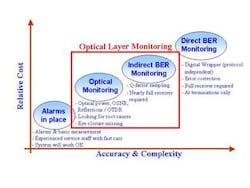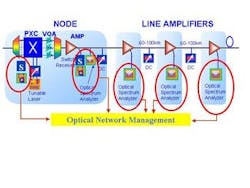Performance monitoring of long-haul networks
By ALEX VUKOVIC, HENG HUA, and MICHEL SAVOIE
Communication Research Centre
Telecommunication transmission systems continue to evolve towards higher data rates, increased wavelength numbers and density, longer transmission distances, and more intelligence. Further development of DWDM and all-optical networking (AON) technologies will require ever-tighter monitoring to assure an agreed quality of service (QoS), characterized by network availability and bit-error rate (BER). Applying traditional monitoring methods to next-generation optical networks can become a complex proposition. For the purpose of obtaining information quickly and accurately in future transmission systems, new monitoring schemes need to be developed and deployed.
Drivers for optical performance monitoring
The basic goal of optical layer monitoring is to prevent network downtime. To accomplish that, an optical monitoring system is required to detect, identify, and localize optical degradations and provide critical inputs to protection switching, equalization, and span management functions. Taking action before transmission errors occur would ensure a high QoS for the network.
Traditional ring-based networks cannot efficiently handle the tremendous growth and dynamic nature of bandwidth demand. With the emergence of photonic switching technology, service providers will have an opportunity to deploy optical mesh networks, which will provide more efficient utilization of WDM networks. There is an economical impact in deploying a mesh topology, resulting in increased revenue opportunities and lower capital and operational costs. Optical performance monitoring plays a key role in assuring redundant protection, bandwidth availability, dynamic traffic re-routing, and tracking of the optical signals and number of channels in use. Additionally, due to network dynamics, real-time compensation schemes may be applied.
Therefore, the main drivers toward new performance monitoring schemes in next generation optical networks are:
• Increasing deployment of all optical networks, i.e. faster transmission rates, longer distances, and ever-higher density (tight channel spacing)
• New network architecture characterized by mesh topology
• Stringent customer requirements for guaranteed QoS.
Because traffic is growing faster than revenue, the main challenge for network providers is to reduce the cost of managed bit per km while controlling the signal (i.e. QoS to ever-tighter tolerances).
Performance monitoring techniques
Although monitoring may reduce the risk of a failure to a minimum, it cannot be considered a compensating mechanism for system deficiencies. In high data rate (40-Gbit) DWDM systems, signal characterization parameters such as channel power, optical signal-to-noise ratio (OSNR), dispersion, or non-linear distortion will require close observation and, for some of them, active compensation or balancing (polarization mode dispersion, channel balancing/equalization after amplification, etc.). To be able to cope with QoS over long distances, performance-monitoring techniques--based on both analog and digital parameters--have to be considered.
Figure 1 presents evaluated monitoring techniques. The analog parameter measurement technique of most interest for next-generation systems is optical spectral analysis (OSA), i.e. optical channel analyzer (OCA). In addition to providing information about OSNR, OSA also provides feedback for active control of the total output power, wavelength frequency allocation, and balancing power between optical channels (after amplification). OSA can also determine which channels are active and provide feedback if power and OSNR are not within acceptable levels.
Since access to electrical signals is moving towards the edges of the network, OSA will play an important diagnostic role in adding and dropping optical signals in transmission systems. Selected, added, or dropped channels, at any network point, will go through QoS monitoring in the optical domain using the protocol and bit-rate-independent Q-factor test. The Q-factor, proportional to BER, is a statistical measurement based on the analysis of the eye diagram for a given signal. Alternatively, QoS of dropped or added signals might be measured using protocol dependent methods, where signals undergo an optical-electrical-optical (OEO) conversion.
The relationship between analog parameters and the Q-factor must be developed to identify the QoS. Using the simple expression of Q-factor with the OSNR measurement (by OSA or pilot tone technique), the transport system operation may be maintained to an acceptable level by setting the alarm thresholds based on the evaluated value of the Q-factor.
Digital techniques for the characterization of optical signals rely on errored block detection. Blocks in digital form are monitored by an error detection code (EDC), which enables the detection of an errored block with a certain probability. An example of an EDC is Bit Interleaved Parity (BIP) used in SONET/SDH systems. The BIP approach has been adopted for the Digital Wrapper frame in optical transport networks. The BIP code calculated over the frame is written in the overhead of the following frame. At the receiver end, the BIP code is calculated over each frame and compared to the transmitted code, by counting individual code violations or considering each frame as a single block. In ITU-T G.709, it is agreed that applying BIP within the Digital Wrapper frame is sufficient for monitoring channels in the optical domain.
Figure 2 represents the potential application of optical performance monitoring for long-haul systems to detect, identify, and localize optical degradations. Monitoring at the node level ensures signal presence at the input and output as well as sensitivity to both noise and distortion effects. At the line amplifier sites along the DWDM system, monitoring includes measurements of OSNR, channel power and central wavelength, and noise level changes. Overall system performance needs to be coordinated by means of a network management system.
Summary
Transmission systems are becoming more optically complex; therefore, optical layer monitoring is a key enabler for the control and management of next-generation, dynamically reconfigurable optical networks to provide a high QoS and flexible services.
Analog and digital techniques will play complementary roles in next-generation optical networks. Optical performance monitoring based on analog parameters may be used inside transparent domains of the network, while standardized techniques based on digital parameters will be necessary to evaluate the end-to-end performance and to activate recovery mechanisms.
Alex Vukovic, Ph.D., P.Eng. is a research scientist at the Communication Research Centre, based in Ottawa, Ontario. He may be contacted via email at [email protected]. Heng Hua, a research engineer at the Communication Research Centre, may be contacted at [email protected], and Michel Savoie, MSEE, P.Eng., research manager at the Communication Research Centre, may be contacted at [email protected].

